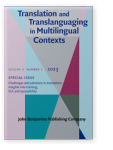Audiovisual mediation through English intralingual and interlingual subtitling
This paper reports on a case study implemented at the University of Salento and, partially, at the Autonomous University of Barcelona, concerning the use of subtitles as a didactic tool to develop intercultural communication skills. This study examines the intralingual and interlingual translations of the reportage Fortress Italia: Capsized in Lampedusa, about migrant arrivals in Italy and Europe. Although the video is of interest to international viewers, the lack of proper subtitling may undermine its accessibility to non-native English speakers. On the one hand, subtitles do not appear when Standard English is used, so the comprehension of those utterances depends on the receivers’ listening skills; on the other hand, the official retextualizations are characterized by formal register and editorial additions that may affect their readability. For these reasons, an alternative rendering was commissioned to a number of undergraduate and postgraduate students of Translation and Interpreting, in order to enquire into new areas of adoption of English as an International Language and as a Lingua Franca. The analysis of the selected corpus of extracts will pinpoint the strategies of lexical and structural simplification and condensation, along with the selection of specific verb tenses and aspects, which are expected to enhance the envisaged recipients’ understanding of the video’s message. Since these features of English are actively selected, by the subjects that were involved in this research, so as to foster cross-cultural communication between the authors and viewers of the news report, this study contends that specific lingua-franca uses can be activated when subtitling multimodal texts. Hence, the notion of ‘audiovisual mediation’ will be introduced in order to label an approach to audiovisual translation aiming to: (i) make the illocutionary force accessible and acceptable to the envisaged, international audience; and (ii) overcome the conventional associations between dubbing and domestication, and subtitling and foreignization.
Article outline
- 1.Introduction, research hypothesis and rationale
- 2.From Audiovisual Translation to Audiovisual Mediation
- 3.Research method and objectives
- 4.Analysis
- 4.1Translation of non-native English speakers’ utterances
- 4.2Analysis and translation of Italian speakers’ utterances
- 5.Conclusions
-
References
